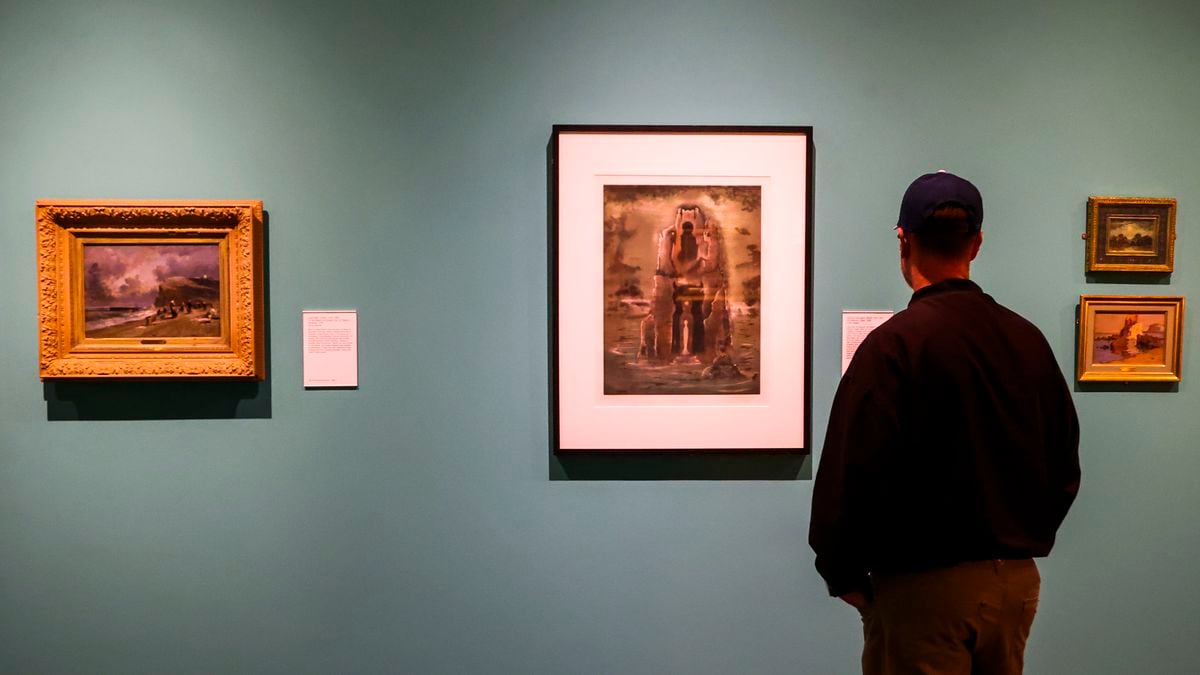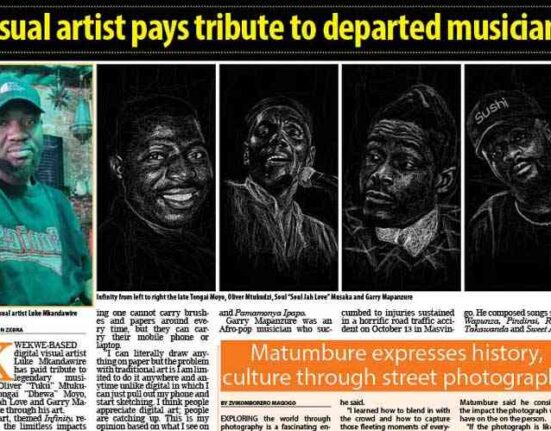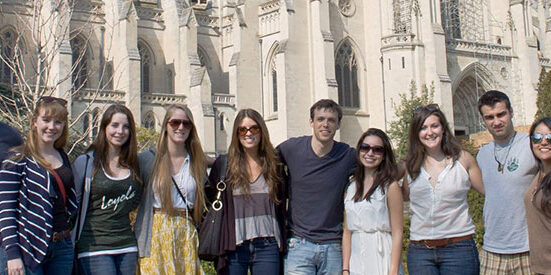ST. PETERSBURG — Sorry, folks, but I can’t give you a complete review of “The Nature of Art” at the Museum of Fine Arts, St. Petersburg.
It’s not for lack of trying. I’ve been to see it twice, but new artwork continues to be added and I can’t keep returning. I have a feeling most people who pay to see this exhibition will want to see it all at once, too.
The museum said the exhibition was planned to unfold in phases, which seems pretty unconventional. It’s definitely a puzzling strategy, especially since that part wasn’t announced until I asked about it specifically.
There has been a fair amount of unrest at the museum lately. In November, it was announced that CEO and executive director Anne-Marie Russell would be stepping down in March. The staggered departure came after a period of tension and upheaval that included the resignation of several key staff members and the firing of the museum’s senior curator of ancient art, Michael Bennett.
While Russell was in charge, I became curious about what happened to the special exhibitions that must have been planned for the year. It’s customary for those to be on the books well in advance and advertised on the Upcoming Exhibitions page on the museum’s website, but that was blank for months. (My question to the museum about this went unanswered.)
It was finally announced in August that “The Nature of Art,” the only exhibition planned for the fall and spring, would draw from the permanent collection and include works from “living artists” who weren’t named until a subsequent news release in November.
The exhibition’s goal as stated by the museum is to look at “the disparate ways humans have engaged in artistic expression to understand our environment, mediate our relationship with nature, and attain a more profound comprehension of our role within the world.”
This statement felt didactic and out of character for the city’s oldest museum — an encyclopedic one that has a long history of presenting a multitude of compelling exhibitions.
This exhibit was curated as a collaboration between Russell, chief curator Stanton Thomas and curator of contemporary art Katherine Pill. Thomas and Pill both have strong curatorial track records at the museum, but some aspects of this exhibition feel out of character for them, too.
It’s on display throughout the museum, in the Volk Wing where the permanent collection is on display and in the Hough Wing and intimate upstairs gallery, where special exhibitions are usually presented. Given the sparseness of the presentation in the Hough Wing (when I saw it), it seems odd to spread it out.
Again, I don’t have the full picture of the exhibition, but I’m not suggesting that you shouldn’t see it. There are some real gems that I thoroughly enjoyed.
The first “wow” moment was right at the entrance of the Hough Wing: a wall covered in paper designed by Brooklyn-based artist Duke Riley, depicting the debris of plastics found in the polluted oceans, titled “Tidal Fool.”
Planning your weekend?
Subscribe to our free Top 5 things to do newsletter
We’ll deliver ideas every Thursday for going out, staying home or spending time outdoors.
You’re all signed up!
Want more of our free, weekly newsletters in your inbox? Let’s get started.
It’s a perfect backdrop to the plastic objects Riley pulled from beaches and intricately decorated to resemble the scrimshaw sailors would etch on whale bones and teeth. The sculptures were made for the fictional Poly S. Tyrene Memorial Maritime Museum.
The other side of the movable wall is covered in another series of Riley’s custom wallpaper made by Brooklyn-based Flavor Paper. “Wall Bait” depicts what appear to be fishing lures but, again, they’re composed of plastic objects pulled from the water. It becomes a fun game of identifying what they are. Its juxtaposition with an 1872 parlor cabinet is nice.
Riley’s works bridge two sections that deal with the peril of overconsumption (displayed with intricate works in elephant ivory, coral, tortoise shell and ebony from the collection) and the nuance of water — at once essential and life-threatening.
The water section is the most robust in the whole exhibition. It includes pieces that serve as cautionary tales, like Alexis Rockman’s haunting painting “The Calms of Capricorn,” which depicts an abandoned ship run aground for lack of water. It’s flanked by two paintings from the collection: “Silver Day,” a view of New York’s East River by George Bellows (1912), and “View of Rouen From the Banks of the Seine” by Joseph Delattre. Those reflect a less urgent relationship with water.
It also includes works that celebrate water, like a wonderful untitled painting by Haitian artist Gérard Valcin depicting a Vodou ceremony happening in the ankle-deep waters of a beach.
The exhibition took a turn for the sparse in the next gallery, which is the largest one in the wing. But it’s a suitable space for the installation of four massive industrial debris booms by art collective Postcommodity that pack a monumental explanation.
The booms are used to catch and store environmental contaminants and their colors refer to the threats they pose, such as flammable and radioactive. But Postcommodity attributes the colors to those of Indigenous medicine and envision the booms as a large snake chopped into four parts, each representing an area of the colonial map of the Western Hemisphere.
Its title, “inaypikowiyâs,” is a Plains Cree word meaning snake meat. “Divided by borders, Postcommodity assert that all people living in the Americas are riding on the back of this snake,” says the piece’s description. “Acknowledging this divided state, Postcommodity calls for border-crossing discourses led by indigenous peoples throughout the Americas about land, resources, and shared knowledge.”
The installation shares the gallery with a series of photographs by James Casabere, who builds the sculptures and models of domestic scenes under the looming threat of natural disasters like wildfires and floods.
Daniel Lind-Ramos’ “Centinelas de la luna nueva (Sentinels of the New Moon)”was the only work to occupy the next gallery (at that time). The Puerto Rican artist assembled the figures from found objects, imbuing anthropomorphic qualities to these “elders of the mangroves.” Given how important mangroves are for protecting the coastline and filtering pollutants, one feels the gravity of these protectors. But it could be more impactful if there was some element representing the mangroves, and the installation feels lonely in that space.
Over the last year, the four-part installation series titled “Tempus volat, hora fugit, (Time flies, hours flee),” by Los Angeles-based artist Christian Sampson, has been on display in the museum’s conservatory. Sampson placed dichroic and vinyl film on the windows, which casts colorful plays of light across the walls, ceiling and floor.
Sampson staggered the installations to coincide with the seasonal equinoxes, so he made frequent visits to the museum. This gave him the opportunity to delve into the museum’s collection to find artwork to riff on for “The Nature of Art.”
He chose two Impressionist works: “The Church at Montigny, Effect of Sunlight” by Francis Picabia and Claude Monet’s “The Houses of Parliament, Effect of Fog, London,” which is one of the museum’s most important pieces.
With his piece “Projection Painting,” Sampson furthers the exploration of light central to those pieces with acrylic, film and LED lights. Its vibrant shadows “paint” the wall in a dramatic effect.
French-American artist Sarah Meyohas was also tapped to respond to works in the collection for the exhibition. She chose Georgia O’Keeffe’s “Poppy” from 1927, one of eight concentrations on the flower, with its luscious gradients in orange. O’Keeffe is often regarded as a feminist role model in the art world. With her piece “Interference #19,″ Meyohas places the female nude figure in nature, using holograms and black mirrors. Like O’Keeffe, she focuses in on the natural forms of the plant life, while also making a feminist statement about reclaiming the female nude.
In an intimate gallery upstairs is a video installation titled “Blood, Sea” by German-Brazilian artist Janaina Tschape. It was filmed at Weeki Wachee, where Tschape collaborated with the mermaids to create a mesmerizing film. She explores the myths of water spirits from a variety of cultures. It’s sublimely meditative. (I’m told another piece by Tschape has also been added.)
While the museum goes through this transitional phase — the board is conducting a national search for Russell’s replacement — we can only be hopeful for what the future holds.
I’ll be returning soon to see “Ahua Can,” a site-specific installation by Mexican American artist Claudia Peña Salinas, which is open now. It includes a sculpture the museum acquired through funds provided by the Expo Chicago 2023 Northern Trust Purchase Prize.
What to know if you go to “The Nature of Art”
“The Nature of Art” is on view through April 14. $12-$22. 10 a.m.-5 p.m. Tuesday-Saturday, noon-5 p.m. Sunday. 255 Beach Drive NE, St. Petersburg. 727-896-2667. mfastpete.org.







